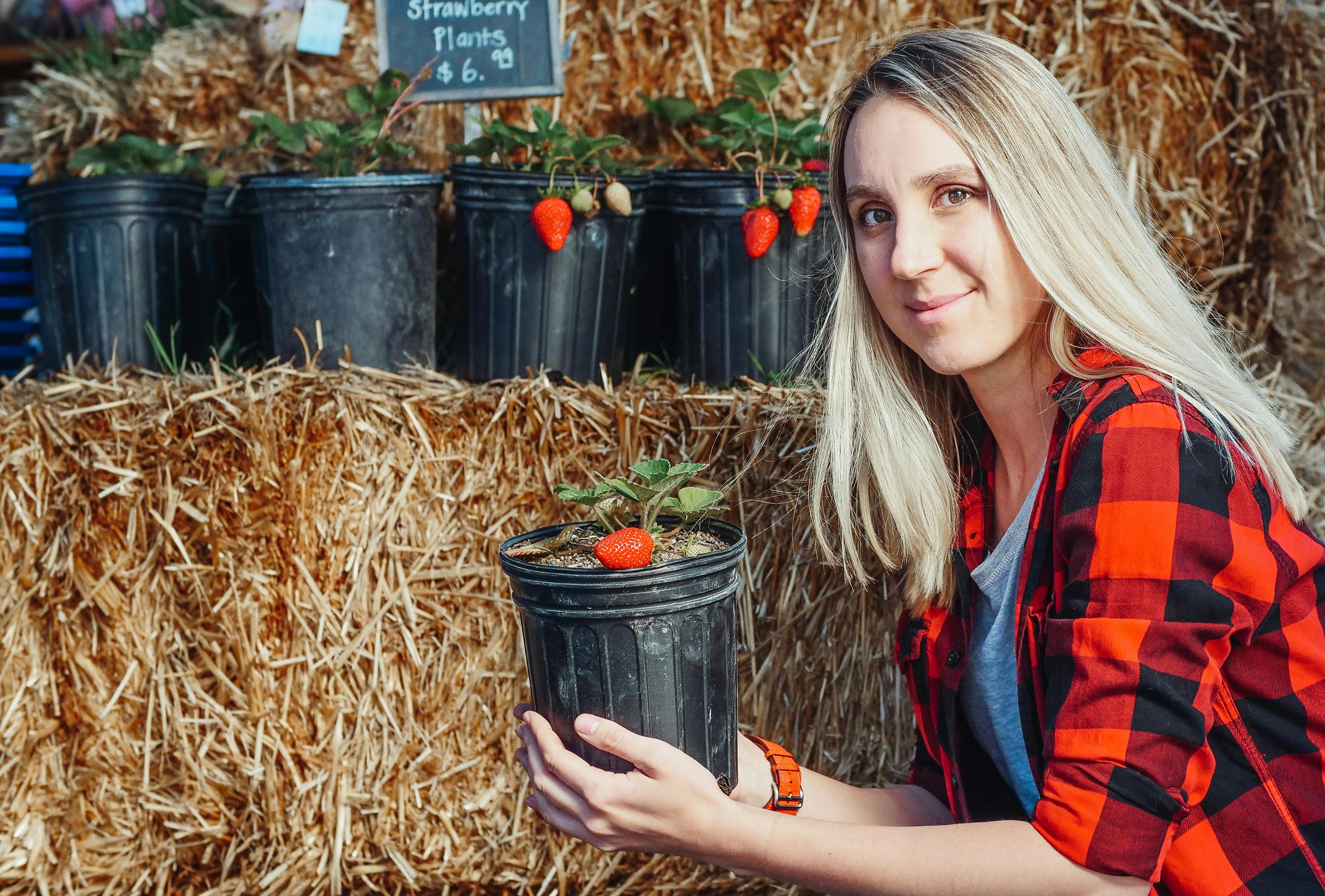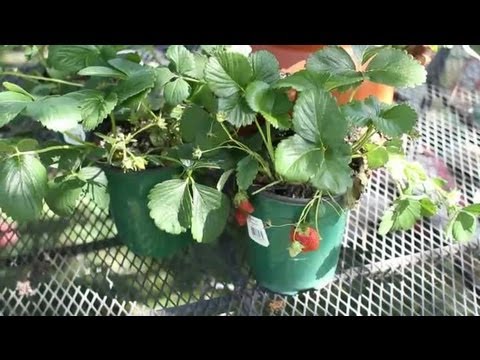Everbearing strawberries are a great addition to any garden. They are easy to grow and produce delicious, sweet fruit throughout the summer months. Planting everbearing strawberries requires some preparation and careful attention to detail, but the end result is worth the effort. In this guide, we will go through the steps necessary to plant everbearing strawberry plants for a successful crop.You will need a few things to successfully plant everbearing strawberries: pots or raised beds, potting soil or soil mix, a hose or watering can, mulch, and strawberry plants. Make sure you choose a spot with plenty of sun (6-8 hours per day) and well-draining soil. Fill the pots or raised beds with potting soil or soil mix and dig small holes for each strawberry plant. Place the plants in the holes, cover with soil, and water thoroughly. Add mulch around the plants to help retain moisture. After planting is complete, water regularly and fertilize once a month for best results.
Preparing the Soil for Planting Everbearing Strawberries
Everbearing strawberries are a popular choice for both home gardeners and commercial farmers, as they continue to produce fruit over multiple seasons. Therefore, it is important to ensure the soil in which these plants are grown is properly prepared before planting. The following steps should be taken when preparing the soil for planting everbearing strawberries:
1. First, it is important to remove all weeds and grass from the area where you plan to plant your everbearing strawberries. This can be done by hand or with a tiller. Once all weeds and grass have been removed, use a garden rake to level off the area so that it is easy to work with.
2. The next step is to add organic matter such as compost or aged manure to the soil. This will help improve drainage and aeration of the soil while also providing essential nutrients for healthy plant growth. After adding these materials, work them into the top 6-10 inches of soil with a garden tiller or shovel.
3. Once you have added organic matter and worked it into the top 6-10 inches of soil, it is time to test your soil’s pH level using a pH testing kit or strips available at most garden centers. Everbearing strawberries prefer slightly acidic soils with a pH level between 5.5-6.8; if your soil’s pH level falls outside of this range, you can add lime or sulfur as needed in order to adjust its acidity levels accordingly before planting your everbearing strawberry plants.
4. Finally, once your soil has been prepared and tested for acidity levels, you can add a balanced fertilizer such as 10-10-10 or 12-12-12 according to its instructions and then work it into the top 4-6 inches of soil; this will provide additional nutrients for healthy plant growth throughout the season(s).
By following these steps when preparing your soil for planting everbearing strawberries, you can ensure that your plants will thrive while producing an abundance of delicious fruit over multiple seasons!
Choosing The Right Variety Of Everbearing Strawberry Plants
When choosing the right variety of everbearing strawberry plants, it is important to consider several factors. Climate and soil conditions, as well as plant size and disease resistance should all be taken into account. In addition, everbearing strawberries can produce fruit throughout the spring and summer months, making them an ideal choice for gardeners looking for a continuous supply of fresh berries.
Climate is one of the most important factors to consider when selecting an everbearing strawberry variety. Plants that are adapted to warmer climates can be grown in cooler climates, but may not produce as many fruits or as large a crop compared to those native to the region. On the other hand, plants native to cooler climates will not fare well in warmer areas due to their inability to tolerate high temperatures. Therefore, it is important to select an everbearing strawberry variety that is well-suited for your local climate.
Soil conditions should also be taken into account when selecting an everbearing strawberry variety. Most varieties prefer a slightly acidic soil with good drainage and plenty of organic matter. In addition, it is important to ensure that the soil has adequate levels of potassium and phosphorus in order to ensure maximum fruit production. If your soil does not meet these requirements, you may need to amend it before planting your berries.
The size of the plant is another factor that should be considered when selecting an everbearing strawberry variety. Smaller varieties are better suited for areas with limited space or for small containers on decks or porches. Larger varieties are better suited for larger gardens and will provide a greater yield over time if cared for properly.
Finally, it is important to consider disease resistance when selecting an everbearing strawberry variety. Some varieties are more resistant than others and this can make a huge difference in terms of pest control and overall health of your plants over time. Be sure to research each variety thoroughly before making your final selection so you can choose one that will perform best in your particular climate and soil conditions.
Planting And Space Requirements For Everbearing Strawberries
Everbearing strawberries are a great choice for growers looking to maximize their crop. They provide an extended season of fruit production, typically from June through October. When planting everbearing strawberries, it’s important to consider the right spacing and planting techniques to ensure a bountiful harvest. To ensure a successful strawberry patch, there are some key points to consider when it comes to planting and space requirements.
When planting everbearing strawberry plants, the general rule is to provide 6-8 inches of space between plants and 18-24 inches between rows. This allows for maximum air circulation and plenty of room for the plants to spread out and produce full-sized berries. The soil should be well-draining and enriched with organic matter like composted manure or peat moss. It’s also important to keep the soil moist throughout the growing season by applying one inch of water per week during dry periods.
In addition, everbearing strawberry plants should be planted in slightly mounded rows or beds that are at least 12 inches high and 2 feet wide. This will help ensure that the plants have good drainage and will also make it easier for gardeners to access the plants for pruning and harvesting purposes. Mulch can also be applied around the base of each plant to help keep moisture in, reduce weeds, and protect against temperature extremes.
When it comes to selecting varieties of everbearing strawberries for your garden, there are many different options available that offer great flavor profiles and unique characteristics. Some popular varieties include ‘Quinault’, ‘Sequoia’, ‘Albion’, ‘Tribute’, ‘Earliglow’ and ‘Festival’. These varieties all produce sweet berries with excellent flavor profiles that ripen in late summer through early autumn months.
By following these planting tips, gardeners can have a successful strawberry patch that will provide delicious fruit for many years to come!
Water and Fertilizing Requirements for Growing Everbearing Strawberries
Everbearing strawberries are a great choice for gardeners who want to enjoy a continuous harvest of plump, juicy berries throughout the growing season. These hardy plants are easy to grow and require minimal care, however, they do need adequate water and fertilizer to produce a bountiful crop. Knowing the best watering and fertilizing techniques for everbearing strawberries will help you maximize your harvest.
It is important to keep everbearing strawberries well-watered throughout the growing season. These plants are shallow-rooted and can dry out quickly in hot weather, so it is important to check soil moisture levels regularly. When the soil feels dry just below the surface, water deeply until the soil is moistened down to 6 inches deep. Watering in the morning is best as it gives the foliage time to dry off before nightfall, reducing disease problems.
Fertilizing everbearing strawberries is also important for optimal growth and production of fruit. Apply a balanced fertilizer such as 10-10-10 or 16-16-8 once every two weeks during active growth periods or when new leaves appear. If you live in an area with alkaline soils, use an acidifying fertilizer such as 5-10-10 or 10-20-20 instead. Avoid overfertilizing as this can lead to excessive foliage growth with few berries produced.

How To Plant Bare-Rooted Everbearing Strawberry Plants
Planting bare-rooted everbearing strawberry plants is a great way to add color and flavor to your garden. Strawberries are easy to grow and require minimal maintenance, making them ideal for beginner gardeners. With a few simple steps, you can have a thriving strawberry patch in no time at all. Here’s how to plant bare-rooted everbearing strawberry plants:
1. Select Healthy Plants: When selecting your everbearing strawberry plants, look for healthy plants with good root systems. Avoid any that appear wilted, diseased, or damaged in any way.
2. Prepare the Soil: Before planting, make sure the soil is well drained and lightly amended with compost or other organic matter. This will help the roots take hold and ensure the plants get all the nutrients they need to thrive.
3. Plant Your Strawberries: Plant your everbearing strawberries 18 to 24 inches apart in rows that are at least 3 feet apart. Make sure each plant is planted deep enough so that it’s covered up to its crown (the point where the leaves meet the stem). Give each plant a thorough watering after it’s been planted.
4. Mulch: After planting, apply a 2-inch layer of organic mulch around each plant. Mulching helps keep moisture in the soil and prevents weeds from taking over your strawberry patch.
5. Water Regularly: Strawberries need plenty of water during their first year of growth so they can establish strong roots and produce lots of fruit later on. Water your plants deeply every two weeks during their first season and adjust accordingly based on weather conditions.
Following these steps will give you a healthy crop of delicious strawberries that will last for many years to come!
Managing Weeds In An Everbearing Strawberry Patch
Maintaining a healthy everbearing strawberry patch requires regular and effective weed management. Weeds can compete with the strawberries for light, water, and nutrients, and can also provide ideal habitats for pests and diseases. Therefore, it is important to remove weeds regularly in order to maintain a productive patch.
The best way of controlling weeds in an everbearing strawberry patch is by manual removal. Hand-pulling or hoeing are both effective methods for removing weeds from the patch. These methods require some effort but are relatively simple to do and are a good way of ensuring that only the weeds are removed without damaging the strawberry plants.
Another option is the use of mulches in the patch. Organic mulches such as straw or grass clippings can be laid down over the soil surface to help suppress weed growth and also help conserve soil moisture levels. It is important to ensure that the mulch layer is thick enough to prevent light reaching weed seeds which may otherwise germinate beneath it.
Herbicides can also be used for weed control in everbearing strawberry patches but should only be used when absolutely necessary as they may damage or kill other plants in the area as well as harm beneficial insects. Care should also be taken when applying herbicides as these chemicals can easily contaminate water supplies if applied incorrectly or not according to instructions on the label.
In summary, effective weed management is essential for a healthy everbearing strawberry patch. Manual removal and mulching are both good ways of controlling weeds in such patches while herbicides should only be used when absolutely necessary due to their potential risks to other plants and beneficial insects in the area.
Controlling Diseases And Pests In An Everbearing Strawberry Patch
Strawberry patches can be a great addition to any garden, providing delicious fruit to enjoy throughout the growing season. However, diseases and pests can quickly take over a strawberry patch if not managed properly. To ensure that your everbearing strawberry patch remains healthy and disease-free, it is important to take proactive steps to control these potential problems.
The first step in controlling diseases and pests is proper maintenance of the patch. This includes removing dead or diseased plants as soon as possible and maintaining adequate soil drainage. Fertilizing regularly with a balanced fertilizer will also help keep your plants healthy and strong. Additionally, avoid crowding plants; this will help prevent the spread of disease-causing pathogens from one plant to another.
One of the most common diseases affecting strawberries is gray mold, which causes leaves to become discolored and covered in white spots. It can also cause the fruit to rot before it can be harvested. To reduce the risk of gray mold, make sure that any infected leaves are removed immediately and avoid overhead watering or wetting of foliage whenever possible. If you do need to water your plants, be sure to use drip irrigation or other soil-focused methods rather than overhead sprinklers or hoses.
Another common issue for strawberry patches is pest infestations such as aphids, thrips, mites, slugs, caterpillars, and other small insects. To control these pests organically, consider using beneficial insects such as ladybugs or lacewings to prey on the pests naturally. You can also use insecticidal soaps or horticultural oils as a last resort if necessary. Additionally, practice good sanitation by removing any fallen leaves or other debris that could harbor pests near your plants.
Finally, remember that prevention is key when it comes to controlling diseases and pests in an everbearing strawberry patch. By taking proactive measures such as proper maintenance and sanitation practices as well as controlling pests organically with beneficial insects, you can ensure that your strawberry patch remains disease-free throughout the growing season for years to come!

Conclusion
Planting everbearing strawberries is not as complicated as it may seem. The key is to choose the right type of strawberry for your climate and soil conditions, and to prepare the soil with good drainage and plenty of organic matter. Plant the strawberries in full sun for best results. Keep them well watered and mulch them with straw or grass clippings to help conserve moisture. If you’re growing in containers, use a high-quality lightweight potting mix with plenty of organic matter. Feed your strawberry plants regularly with a balanced fertilizer and remove any flowers during the first season to encourage more leafy growth. Once they are established, your everbearing strawberries will provide you with a steady supply of juicy, sweet berries for years to come.
With proper care and attention, you can enjoy a bountiful harvest of everbearing strawberries each year. Plus, they’re easy to grow and require minimal maintenance — making them an ideal choice for both novice and experienced gardeners alike!



